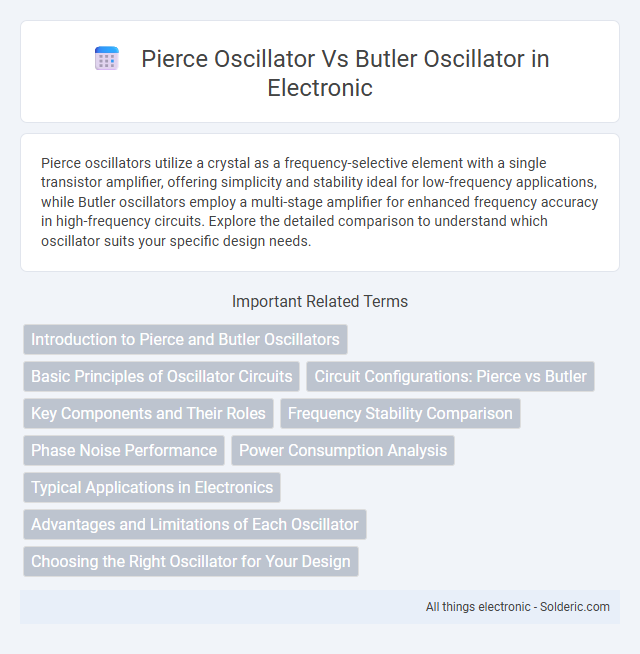Pierce oscillators utilize a crystal as a frequency-selective element with a single transistor amplifier, offering simplicity and stability ideal for low-frequency applications, while Butler oscillators employ a multi-stage amplifier for enhanced frequency accuracy in high-frequency circuits. Explore the detailed comparison to understand which oscillator suits your specific design needs.
Comparison Table
| Feature | Pierce Oscillator | Butler Oscillator |
|---|---|---|
| Oscillator Type | Crystal-controlled voltage oscillator | Crystal-controlled voltage oscillator with buffer stage |
| Frequency Stability | Moderate to high | High, better isolation improves stability |
| Circuit Complexity | Simple, fewer components | More complex, additional buffer stage |
| Phase Noise | Moderate | Lower phase noise due to buffer |
| Output Signal | Direct output from inverter/amp stage | Buffered output, cleaner signal |
| Typical Applications | Basic clock generation, microcontrollers | High precision frequency references and communication systems |
| Power Consumption | Lower power due to simple design | Higher power due to buffer stage |
Introduction to Pierce and Butler Oscillators
Pierce and Butler oscillators are fundamental crystal oscillator circuits used for generating stable frequency signals in electronic devices. The Pierce oscillator utilizes a single transistor or inverter with a feedback loop through a crystal, favoring simplicity and low power consumption for microcontroller clock generation. The Butler oscillator employs a more complex, multi-stage amplifier design providing enhanced frequency stability and reduced phase noise, making it suitable for precision timing applications and RF systems.
Basic Principles of Oscillator Circuits
Pierce oscillators operate using a crystal and a single transistor or inverter to establish a stable frequency by amplifying the crystal's natural resonance. Butler oscillators utilize a crystal in a feedback loop with a tuned LC network and dual transistors or tubes, providing enhanced frequency stability and reduced phase noise. Understanding these basic principles helps you select the appropriate oscillator type for applications requiring precise frequency control.
Circuit Configurations: Pierce vs Butler
Pierce oscillator circuits typically use a single transistor or inverter amplifier with a crystal connected between the input and output, offering simplicity and low component count ideal for stable frequency generation in microcontrollers and clocks. Butler oscillators employ a more complex configuration with a crystal and a tuned transformer or inductor, providing enhanced frequency stability and lower phase noise suited for high-performance RF applications. Your choice between Pierce and Butler configurations depends on the required frequency stability, complexity, and application-specific performance criteria.
Key Components and Their Roles
A Pierce oscillator primarily uses a quartz crystal, two capacitors, and a single transistor or inverter to maintain stable oscillations by leveraging the crystal's mechanical resonance. In contrast, a Butler oscillator incorporates a quartz crystal, a single transistor or amplifier, and a series of inductors and capacitors forming a feedback network to achieve frequency stability. Your choice between them depends on the desired frequency stability and circuit complexity, where the Pierce oscillator offers simplicity, and the Butler oscillator provides enhanced harmonic suppression.
Frequency Stability Comparison
The Pierce oscillator offers good frequency stability due to its simple design and low component count, which minimizes phase noise and thermal drift. The Butler oscillator provides superior frequency stability by using a crystal with a high-quality factor and an improved feedback network that reduces frequency variations under temperature and load changes. Your choice depends on whether simplicity or maximum frequency precision is more critical for your application.
Phase Noise Performance
Pierce oscillators typically exhibit lower phase noise due to their simpler design and fewer active components, making them ideal for applications requiring clean signals. Butler oscillators, while offering higher frequency stability, often experience increased phase noise because of their regenerative feedback loop and complex configuration. Selecting the right oscillator depends on your need for balancing phase noise performance against frequency stability in precision circuits.
Power Consumption Analysis
The Pierce oscillator typically consumes less power compared to the Butler oscillator due to its simpler circuit design and fewer active components, making it ideal for low-power applications. The Butler oscillator's higher power consumption arises from its additional amplifier stages, which provide enhanced frequency stability but at the cost of increased energy usage. In battery-operated and portable devices, the Pierce oscillator's efficiency significantly extends operational life by minimizing current draw.
Typical Applications in Electronics
Pierce oscillators are commonly used in clock generation circuits for microcontrollers and digital systems due to their simplicity and stability in producing a clean sine wave at high frequencies. Butler oscillators find typical applications in frequency synthesis and RF signal generation where precise frequency control and low phase noise are critical, often employed in communication equipment and phase-locked loop (PLL) circuits. Both oscillator types serve vital roles in timing and frequency control components across consumer electronics, telecommunications, and signal processing devices.
Advantages and Limitations of Each Oscillator
The Pierce oscillator offers simplicity, low power consumption, and frequency stability, making it ideal for microcontroller clock generation, but it is limited by moderate frequency accuracy and sensitivity to load capacitance variations. The Butler oscillator provides superior frequency stability and precision, especially in high-frequency and temperature-sensitive applications, yet it is more complex and consumes higher power compared to the Pierce oscillator. Your choice depends on whether you prioritize ease of integration and energy efficiency or require enhanced frequency accuracy and environmental stability.
Choosing the Right Oscillator for Your Design
Choosing the right oscillator for your design depends on factors like frequency stability, phase noise, and load requirements. Pierce oscillators are simple, cost-effective, and ideal for low to moderate frequency applications with moderate stability needs. Butler oscillators offer higher frequency stability and better phase noise performance, making them suitable for precise and high-frequency designs where signal purity is critical.
pierce oscillator vs butler oscillator Infographic

 solderic.com
solderic.com